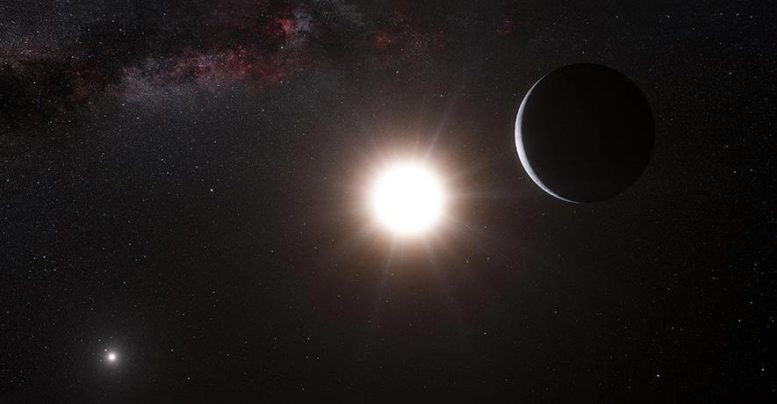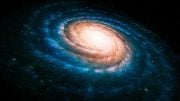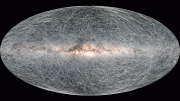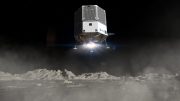
Planet formation in binary systems is more complicated, because the companion star acts like a giant eggbeater, dynamically exciting the protoplanetary disc. Credit: University of Cambridge
Astronomers have developed the most realistic model to date of planet formation in binary star systems.
The researchers, from the University of Cambridge and the Max Planck Institute for Extraterrestrial Physics, have shown how exoplanets in binary star systems – such as the ‘Tatooine’ planets spotted by NASA’s Kepler Space Telescope – came into being without being destroyed in their chaotic birth environment.
“Planet formation in binary systems is more complicated, because the companion star acts like a giant eggbeater, dynamically exciting the protoplanetary disc.” — Roman Rafikov
They studied a type of binary system where the smaller companion star orbits the larger parent star approximately once every 100 years – our nearest neighbor, Alpha Centauri, is an example of such a system.
“A system like this would be the equivalent of a second Sun where Uranus is, which would have made our own solar system look very different,” said co-author Dr. Roman Rafikov from Cambridge’s Department of Applied Mathematics and Theoretical Physics.
Rafikov and his co-author Dr. Kedron Silsbee from the Max Planck Institute for Extra-terrestrial Physics found that for planets to form in these systems, the planetesimals – planetary building blocks which orbit around a young star – need to start off at least 10 kilometers (6.2 miles) in diameter, and the disc of dust and ice and gas surrounding the star within which the planets form needs to be relatively circular.
The research, which will be published in Astronomy and Astrophysics, brings the study of planet formation in binaries to a new level of realism and explains how such planets, a number of which have been detected, could have formed.
Planet formation is believed to begin in a protoplanetary disc – made primarily of hydrogen, helium, and tiny particles of ices and dust – orbiting a young star. According to the current leading theory on how planets form, known as core accretion, the dust particles stick to each other, eventually forming larger and larger solid bodies. If the process stops early, the result can be a rocky Earth-like planet. If the planet grows bigger than Earth, then its gravity is sufficient to trap a large quantity of gas from the disc, leading to the formation of a gas giant like Jupiter.
“This theory makes sense for planetary systems formed around a single star, but planet formation in binary systems is more complicated, because the companion star acts like a giant eggbeater, dynamically exciting the protoplanetary disc,” said Rafikov.
“In a system with a single star the particles in the disc are moving at low velocities, so they easily stick together when they collide, allowing them to grow,” said Silsbee. “But because of the gravitational ‘eggbeater’ effect of the companion star in a binary system, the solid particles there collide with each other at much higher velocity. So, when they collide, they destroy each other.”
Many exoplanets have been spotted in binary systems, so the question is how they got there. Some astronomers have even suggested that perhaps these planets were floating in interstellar space and got sucked in by the gravity of a binary, for instance.
Rafikov and Silsbee carried out a series of simulations to help solve this mystery. They developed a detailed mathematical model of planetary growth in a binary that uses realistic physical inputs and accounts for processes that are often overlooked, such as the gravitational effect of the gas disc on the motion of planetesimals within it.
“The disc is known to directly affect planetesimals through gas drag, acting like a kind of wind,” said Silsbee. “A few years ago, we realized that in addition to the gas drag, the gravity of the disc itself dramatically alters dynamics of the planetesimals, in some cases allowing planets to form even despite the gravitational perturbations due to the stellar companion.”
“The model we’ve built pulls together this work, as well as other previous work, to test the planet formation theories,” said Rafikov.
Their model found that planets can form in binary systems such as Alpha Centauri, provided that the planetesimals start out at least 10 kilometers across in size, and that the protoplanetary disc itself is close to circular, without major irregularities. When these conditions are met, the planetesimals in certain parts of the disc end up moving slowly enough relative to each other that they stick together instead of destroying each other.
These findings lend support to a particular mechanism of planetesimal formation, called the streaming instability, being an integral part of the planet formation process. This instability is a collective effect, involving many solid particles in the presence of gas, that is capable of concentrating pebble-to-boulder-sized dust grains to produce a few large planetesimals, which would survive most collisions.
The results of this work provide important insights for theories of planet formation around both binary and single stars, as well as for the hydrodynamic simulations of protoplanetary discs in binaries. In the future, the model could also be used to explain the origin of the ‘Tatooine’ planets – exoplanets orbiting both components of a binary – about a dozen of which have been identified by NASA’s Kepler Space Telescope.
Reference: “Planet formation in stellar binaries: Global simulations of planetesimal growth” by K. Silsbee and R. R. Rafikov, 17 August 2021, Astronomy and Astrophysics.
DOI: 10.1051/0004-6361/202141139









Be the first to comment on "Astronomers Show How “Tatooine” Planets Form in Binary Systems Without Getting Crushed"